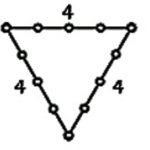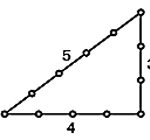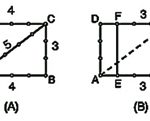Sacred Geometry
1. Sacred Geometry Of Divine Architecture
Geometry to the Ancient Egyptians was much more than a study of points, lines, surfaces, and solids and their properties and measurement. The harmony inherent in geometry was recognized in Ancient Egypt as the most cogent expression of a divine plan that underlies the world—a metaphysical plan that determines the physical.
To the Ancient Egyptians, geometry was the means by which humanity could understand the mysteries of the divine order. Geometry exists everywhere in nature: its order underlies the structure of all things, from molecules to galaxies. The nature of the geometric form allows its functioning. A design using the principles of sacred geometry must achieve the same goal: using form to serve/represent a function.
Herodotus, the father of history and a native Greek, stated, in 500 BCE:
Now, let me talk more of Egypt for it has a lot of admirable things and what one sees there is superior to any other country.
The Ancient Egyptian’s works, large or small, are admired by all because they are proportionally harmonious and, as such, appeal to our inner as well as our outer feelings. This harmonic design concept is popularly known as sacred geometry, where all figures can be drawn or created using a straight line (not even necessarily a ruler) and compass – i.e. without measurement (dependent on proportion only).
2. The Egyptian Sacred Cord [Tool]
Since sacred geometry is based on harmonic proportion, the unit distance (length) can theoretically be any unit. The only needed tool is a cord consisting of 12 equally spaced distances. The unit distance can be small or large, so as to fit the required design of artwork on a canvas, statues, or the layout of buildings.

Temples and other buildings in Ancient Egypt were laid out in a religious ceremony. This laying out was performed by very knowledgeable people who are known to the Greeks as harpedonaptae.
The harpedonaptae are the people who strictly adhered to the principles of sacred geometry (using only a straight line and a compass). Their cord was (and still is, in parts of present-day Egypt) a very special cord that consists of a 13-knot rope with 12 equally-spaced distances of one Egyptian cubit (1.72′ or 0.5236 m).
Any equally-spaced 13-knot cord is the basic tool used to establish various geometric shapes.
3. General Layout Of Geometric Shapes
Triangles are the building blocks of any design.
The simplest formation is the equilateral triangle, which can be set out with the Egyptian rope knotted at twelve equal intervals and wound around three pegs so that it formed three sides, each measuring four units.

The line joining from any corner to the middle of the opposite side is its perpendicular.
However, the origin of the historic building layout was the setting out of the 3:4:5 triangle with the Egyptian rope, wound around three pegs so that it formed three sides measuring three, four, and five units, which provides a 90° angle between its 3 and 4 sides.

It was a relatively simple task to lay out rectangles and other more complex geometrical figures after establishing the 3:4:5 right-angle triangle.
A square EBCF, for example, can be established as shown herein:

(A) Construct two 3:4:5 triangles with a common diagonal AC.
(B) Connect FE where FC = EB = 3 units.
The Egyptian cord can be used as a compass to draw circular curves, as shown in the diagram below.

Other shapes, such as the 8:5 Neb (Golden) triangle or rectangle, as shown below, can also be established with the Egyptian cord.
[To see the formation of a wide variety of geometrical shapes, read Sacred Geometry and Numerology by this same author.]
The hieroglyphic symbol for the neter (god) Re, the cosmic creative force, is the circle. When the cord is looped as a full circle, the archetype of creation, we find that the radius of this sacred circle equals 1.91 cubits. In converting this measurement of 1.91 cubits of the radius into the metric system, we get 1 meter exactly (1.91 x 0.5236). 1 meter = 1/100,000th – part of the quarter of the Earth’s meridian. In other words, this particular 13-knotted Egyptian rope and the Egyptian unit of measurement known as a cubit are based on the measurement of the Earth’s circumference.

Throughout this book, you will find this cord to be the only tool needed to establish all sacred geometric shapes, from a straight line to a curve to other shapes.
[An excerpt from The Ancient Egyptian Metaphysical Architecture by Moustafa Gadalla]
https://egyptianwisdomcenter.org/product/the-ancient-egyptian-metaphysical-architecture/
https://egyptianwisdomcenter.org/product/the-ancient-egyptian-metaphysical-architecture/
